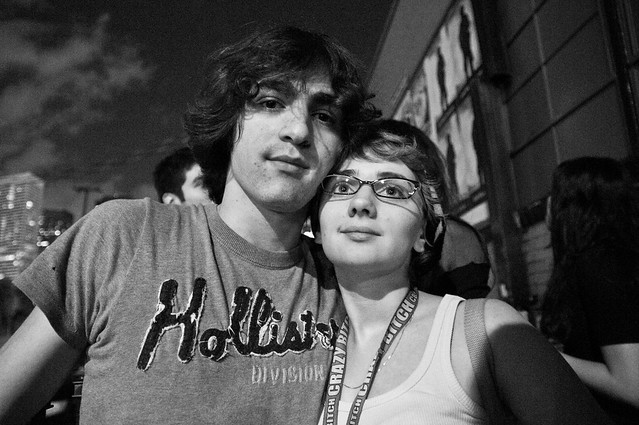Derrel hit the nail on the head in all respects – high ISO speed, near-wide open aperture for improved IQ as most lenses aren’t their sharpest wide open (2.5-2.8ish instead of 1.8), and try to keep the shutter speed as fast as possible to stop subject (and your) movement.
I’ve been ‘fighting’ the exposure triangle for no-flash indoor digital photography for perhaps 10 years. Fast glass and high ISO speeds are critical. But at or near wide-open apertures results in thin DOF, perhaps measured in inches, which makes group shots near impossible to get everybodys’ faces in focus. Check out the DOF tutorial and calculator links below and experiment with your camera/lens/aperture combos to see what thin DOFs you will be forced to deal with.
Understanding Depth of Field in Photography
Online Depth of Field Calculator
In addition to the DOF considerations, choosing shutter speeds to stop subject motion is quite challenging. Even with standing subjects, 1/125[SUP]
th[/SUP] if needed to consistently stop motion. If they’re like me and talk with their hands, their hands may be blurred slightly. But to get that kind of shutter speed, ISO in the 3200 and higher is needed, which, for the T5i, -might- result in too much noise. But as mentioned above, better a shot with noise than a blurry, underexposed image. So the alternative is slower shutter speeds. But the number of throw-aways due to subject movement grows very quickly to 4 out of 5 get tossed, perhaps even more, when you’re shooting at 1/30[SUP]
th[/SUP]. It gets progressively worse at 1/20[SUP]
th[/SUP] and 1/10[SUP]
th[/SUP]. Then, of those remaining, ditch the ones where their eyes are closed, somebody is talking with their mouth wide open, unflattering pictures of any females (be especially cognizant that women never want ‘bad’ pictures o themselves ‘out there’

, and distracting clutter in the background, such as a coat rack, overly colorful wall hangings, etc. I’ve had as few as 1 in 25 ‘keepers’ when shooting in the 1/20[SUP]
th[/SUP]-1/30[SUP]
th[/SUP] range. So if that’s where you have to shoot, so be it. But then use the ‘spray and pray’ method – take lots and lots of pictures expecting that a large number of them will be trashed. At least with digital, it’s free.
One more thing...keep the AF set to AI Servo. That way, the camera will keep focused locked on even if the subject (or you) move slightly during the exposure. Single Shot mode is limited to things that don't move...buildings, bridges, etc.
Lastly, the popup flash isn’t all ‘bad’. Just as ‘insurance’, put the camera on auto and tape a piece of Kleenex to the front of the popup to ‘soften’ and diffuse the light. But remember that the light output of the flash is only good for about 10 feet, with everything further back, dark. That, however, can be useful to hide/darken unnecessary/distracting background clutter and have properly lit subject faces.
I know this is all a giant handful to remember for a newbie to photography. But as I and countless others have learned the hard way…from our mistakes. And practice, practice, practice will ultimately increase your successes.
I think of Thomas Edison, when, after 1000 or more failed attempts to make a lightbulb was asked if he was discouraged. His response was that he now knew 1000 ways NOT to make a lightbulb!









![[No title]](/data/xfmg/thumbnail/32/32181-195f34b5d304506aafc7ec317f64563f.jpg?1734161047)




![[No title]](/data/xfmg/thumbnail/31/31757-4f5257d19be4e34c6bdcbd2519380d53.jpg?1734160480)
